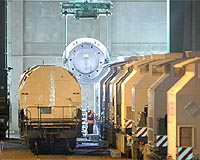 |
Berlin (UPI) Mar 15, 2009 The German government plans to end a 10-year moratorium by reopening research into a potential nuclear waste storage site, a decision that sparked immediate criticism from the opposition. German Environment Minister Norbert Roettgen said Berlin plans a security analysis of the controversial storage site at Gorleben in the state of Lower Saxony. The analysis and construction of a storage site would take 20 years, he said Monday in Berlin. Germany in 1973 identified the unused salt mine as a potential storage site for highly radioactive waste. In 2000, the government composed of the Social Democrats and the Greens halted research there because of political differences and public protests. They were and are in favor of looking for additional, potentially more promising locations. Yet the Greens and the Social Democrats are now in opposition, and Chancellor Angela Merkel's conservatives have favored looking into Gorleben again. They say it's too expensive to look for alternative sites, but critics argue they favor Gorleben because most of the potential replacements are located in states dominated by Merkel's party colleagues. "We will use all our powers to block this cowardly decision," said the leader of the Greens in the European Parliament, Rebecca Harms. Environmental groups also blasted the decision. Reopening research into Gorleben is a "waste of time and money," said Hubert Weiger, the head of the BUND environmental organization. He added that experiences with the salt dome in Asse, where barrels with nuclear waste have leaked and inflowing groundwater threatens to collapse the cavern, show that other geological formations should be explored. "If ... Roettgen concentrates on Gorleben, he gives the interests of nuclear plant owners priority over the population's security interests," Weiger said. Roettgen promised that new research into Gorleben would be open-ended. "Gorleben enjoys priority but not necessarily exclusivity," he said, adding that the security analysis, which will take about seven years, will decide whether Gorleben is "suitable nor not." To understand the controversy that surrounds Gorleben, one has to go back to 1973, when the search for a permanent storage site began. The government identified three promising sites, all in Lower Saxony. Gorleben was not among them. After opposition from state officials the government let Lower Saxony choose its own site. It chose Gorleben, located in a sparsely populated area bordering former East Germany that the state wanted to boost economically. Across Europe, several countries have launched programs to identify possible waste-storage sites; most countries bank on geological formations, some on natural caverns like Finland and Sweden, others on decommissioned mines like Germany and Switzerland, with France planning to first reprocess its spent fuel and to then store smaller amounts in geological formations. Finland has identified a geologic repository near two existing reactors where it aims to store waste sealed in copper-clad containers starting in 2020. France chose a location in 1998 and plans to have a working repository in place hopefully by 2025. U.S. President Barack Obama last year cut funding for the controversial Yucca Mountain nuclear storage project in Nevada, arguing that there are too many questions over its safety -- a clear sign that Washington has no viable answers to the questions tied to nuclear-waste storage.
Share This Article With Planet Earth
Related Links Nuclear Power News - Nuclear Science, Nuclear Technology Powering The World in the 21st Century at Energy-Daily.com
 Transylvania to host new Romania nuclear power plant
Transylvania to host new Romania nuclear power plantBucharest (AFP) March 13, 2010 Romania's second nuclear power station will be built in Transylvania, but its precise location hinges on the technology chosen for it, Economy Minister Adriean Videanu said on Saturday. Complementing the Cernavoda facility in southeast Romania, the new power plant in the heart of the country has been forecast to start operations in 2020 - although delays could put the opening back by 10 yea ... read more |
|
| The content herein, unless otherwise known to be public domain, are Copyright 1995-2010 - SpaceDaily. AFP and UPI Wire Stories are copyright Agence France-Presse and United Press International. ESA Portal Reports are copyright European Space Agency. All NASA sourced material is public domain. Additional copyrights may apply in whole or part to other bona fide parties. Advertising does not imply endorsement,agreement or approval of any opinions, statements or information provided by SpaceDaily on any Web page published or hosted by SpaceDaily. Privacy Statement |